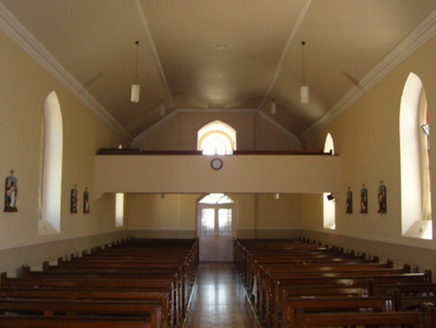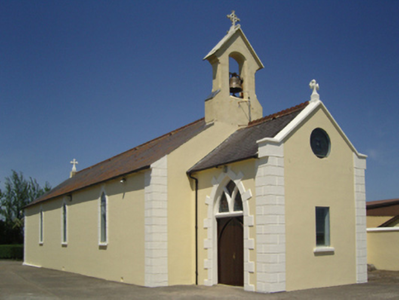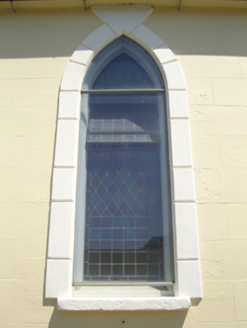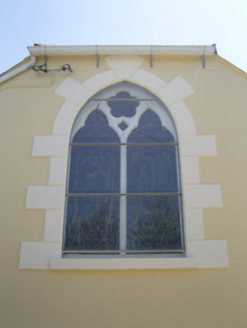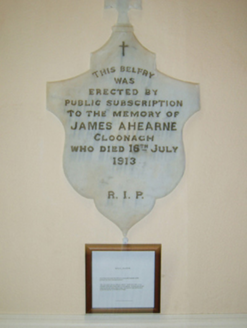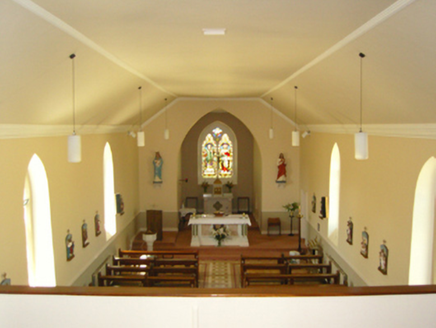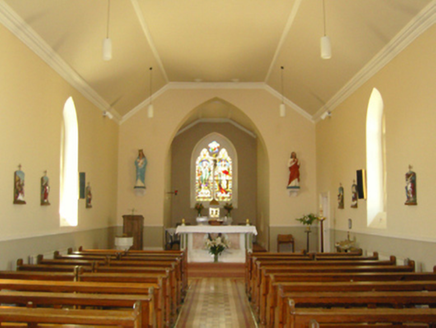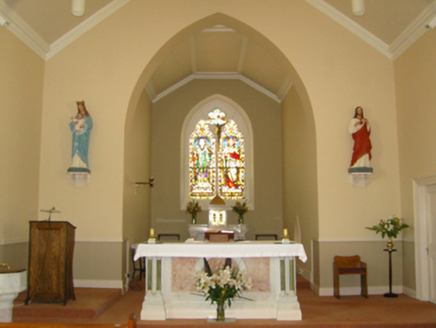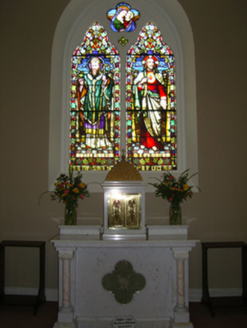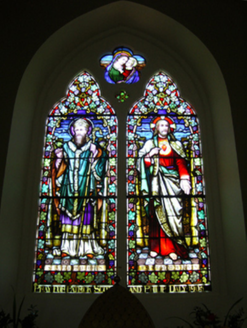Survey Data
Reg No
15704001
Rating
Regional
Categories of Special Interest
Architectural, Artistic, Historical, Social
Original Use
Church/chapel
In Use As
Church/chapel
Date
1825 - 1830
Coordinates
277820, 117811
Date Recorded
31/05/2009
Date Updated
--/--/--
Description
Detached four-bay double-height Catholic church, opened 1826, on a rectangular plan originally three-bay double-height single-cell comprising three-bay double-height nave opening into single-bay double-height chancel (north); single-bay single-storey gabled projecting porch to entrance (south) front. Renovated, ----, with sanctuary reordered. "Restored", 2000. Pitched slate roofs including pitched (gabled) slate roof (porch), trefoil-perforated crested terracotta ridge tiles with rendered, ruled and lined buttressed gabled bellcote to apex (south) framing embossed cast-iron bell ("1884"), concrete "saddleback" coping (porch) on rendered kneelers, and cast-iron rainwater goods on rendered eaves retaining cast-iron downpipes. Rendered, ruled and lined battered walls on rendered chamfered plinth with rusticated rendered piers to corners. Lancet window openings with cut-granite sills, and rusticated rendered surrounds framing storm glazing over fixed-pane fittings having stained glass margins centred on lattice glazing bars. Pointed-arch window opening (north) with cut-granite sill, timber mullion, and rusticated rendered block-and-start surround framing storm glazing over fixed-pane fittings having leaded stained glass panels. Square-headed window opening (porch) with roundel opening (gable), concealed dressings framing storm glazing over fixed-pane fittings. Pointed-arch opposing door openings ("cheeks") with cut-granite thresholds, and rusticated rendered block-and-start surrounds framing replacement timber boarded or tongue-and-groove timber panelled double doors having overlights. Interior including vestibule (south) retaining staircase on a dog leg plan with turned timber "spindle" balusters supporting carved timber banister terminating in chamfered timber newels; pointed segmental-headed door opening into nave with glazed timber panelled double doors having overlight; full-height interior with choir gallery (south), tiled central aisle between timber pews, replacement stations between frosted glass windows, moulded plasterwork cornice to vaulted ceiling, and pointed-arch chancel arch framing carpeted stepped dais to sanctuary (north) reordered, ----, with quatrefoil-detailed cut-veined white marble panelled altar below stained glass memorial "North Window" (1905). Set in relandscaped grounds at angle to road.
Appraisal
A church representing an important component of the early nineteenth-century ecclesiastical heritage of south County Wexford with the architectural value of the composition, one showing the hallmarks of a period of construction coinciding with the gradual dismantling of the Penal Laws in anticipation of the Roman Catholic Relief Act, 1829, confirmed by such attributes as the compact rectilinear "barn" plan form, aligned along a liturgically-incorrect axis; the slender profile of the openings underpinning a "medieval" Gothic theme with the chancel defined by a cusped "North Window"; and the handsome bellcote embellishing the roofline as a picturesque eye-catcher in the landscape. Having been well maintained, the elementary form and massing survive intact together with quantities of the original fabric, both to the exterior and to the vaulted interior reordered (----) in accordance with the liturgical reforms sanctioned by the Second Ecumenical Council of the Vatican (1962-5) where the jewel-like Scott-Daly Memorial "North Window" (1905) highlights the modest artistic potential of a church making a pleasing visual statement in a rural street scene.
